Last weekend saw the NWSL make its long-awaited return, and 2022 is widely expected to be the best season yet. As has become the custom, the Challenge Cup has kicked off the year, giving us an opportunity to closely examine each team before the regular league takes centre stage.
There were plenty of interesting results in the opening round of matches, but one game that caught the eye was San Diego Wave’s trip to fellow California side Angel City. Both are embarking on their first-ever campaigns and have significant names involved in their day-to-day running; Angel City’s founders and part-owners include actress Natalie Portman, tennis legends Serena Williams and Billie Jean King, TV presenter James Corden and USWNT greats Mia Hamm and Abby Wambach, whilst England legend Eniola Aluko is their sporting director. Meanwhile, San Diego are owned by Ron Burkle (who also part-owns NHL side Pittsburgh Penguins) and have 2019 World Cup-winning coach Jill Ellis as their president.
This tactical analysis will look at the finer details of the two sides’ 1-1 draw, seeing why neither could edge the other. The analysis will focus specifically on Angel City’s overall tactics and what it taught us about their style of play this year, as well as San Diego’s attacking setup and some areas that they still need to address.
Lineups

Angel City head coach Freya Coombe named a 4-2-3-1 formation for the club’s first official outing, picking Bosnia goalkeeper DiDi Haracic, who followed her in moving from NJ/NY Gotham, and Olympic gold medal-winning Canada defender Vanessa Gilles. She partnered Madison Hammond in central defence, whilst Jasmyne Spencer and New Zealand captain Ali Riley started either side of them. The holding midfield was made up of Dani Weatherholt and Cari Roccaro, whilst former Racing Louisville player Savannah McCaskill started behind ex-Portland Thorns striker Tyler Lussi. Japan international Jun Endo and former Manchester United Women forward Christen Press were given the wing roles.
San Diego Wave also opted for a 4-2-3-1 formation, and also had a Canada international in their XI; goalkeeper Kailen Sheridan. The defensive line comprised of former Portland right-back Christen Westphal, ex-Manchester City Women centre-back Abby Dahlkemper, 2022 draft pick Naomi Girma and former Washington Spirit defender Tegan McGrady, whilst Taylor Kornieck and Kristen McNabb gave them protection from the midfield. The attacking line consisted of another NWSL debutant, Amirah Ali, and Mexico international Katie Johnson, with both playing either side of Kelsey Turnbow, who also came out of the 2022 draft. Experienced former Lyon Féminin striker Jodie Taylor was chosen to lead the line.
Angel City’s tactics
Whilst the game itself was a good spectacle, what fans really wanted was a basic idea of how both Angel City and San Diego Wave will play this season. We will look at San Diego later, but it was clear early on that Angel City had worked on a style of play in training that relied on good transitional play and having plenty of possession.
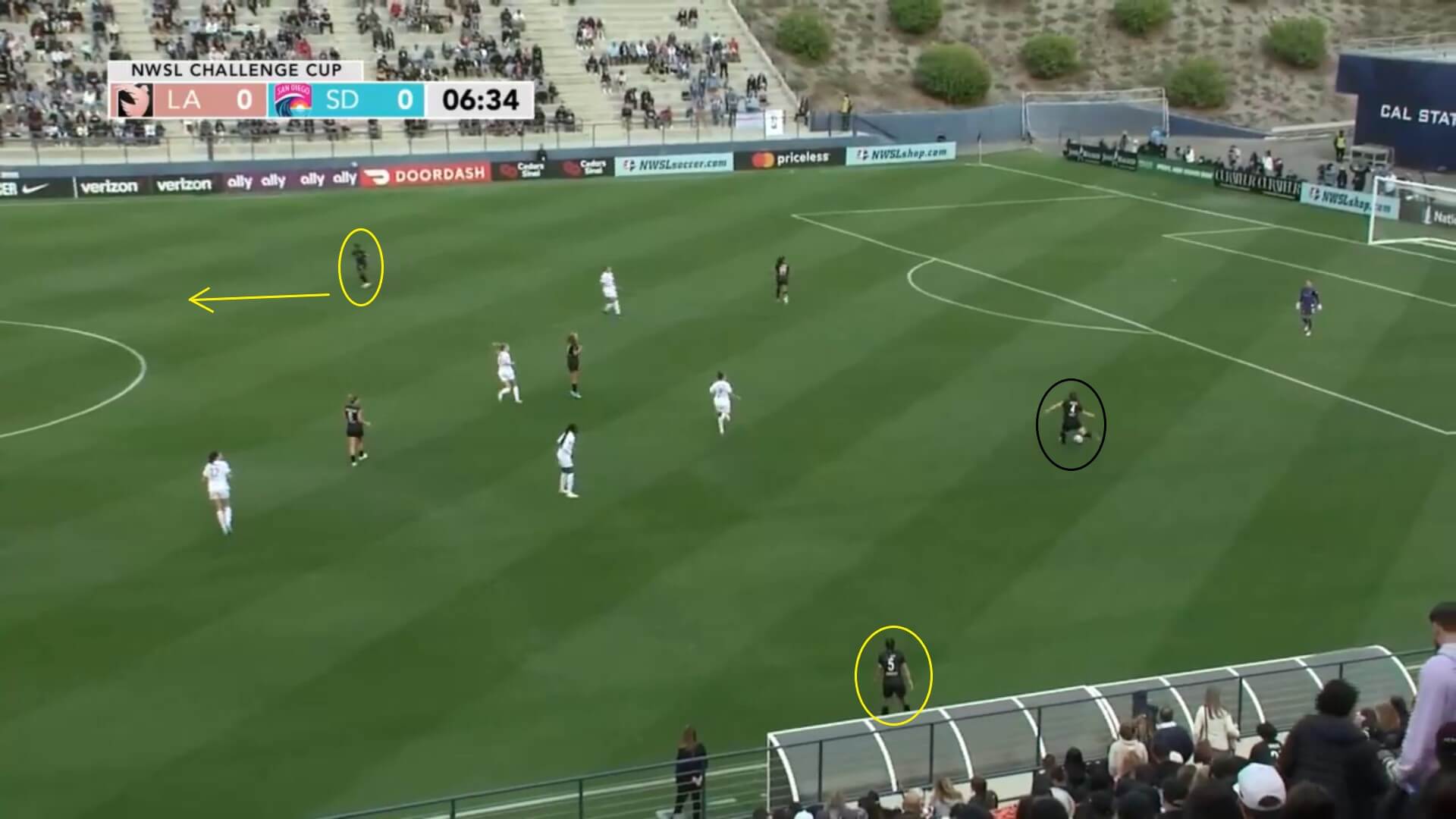
This desire to move the ball forwards with purpose started from the back. Here, they have the ball in their own third, with the defenders spreading out to make the pitch as big as possible, as is normal. However, what was interesting is that Angel City’s two full-backs made early runs in these situations, positioning themselves ahead of the two centre-backs and ensuring that any passes into them would be forwards, not sideways. This helped them to build momentum as early as possible and get on the front foot, making it easier to set up attacks higher up the pitch.
It should be noted that they have been assisted here by San Diego’s narrow setup, which has given Jasmyne Spencer more time to receive the ball than she perhaps ordinarily would have had. However, the fact still remains that she is now alongside the attackers and not in front of them, making it harder for them to close her down, and it was a constant feature of Angel City’s play to see passes being made through gaps in the opposing lines, exploiting spaces that San Diego left open.
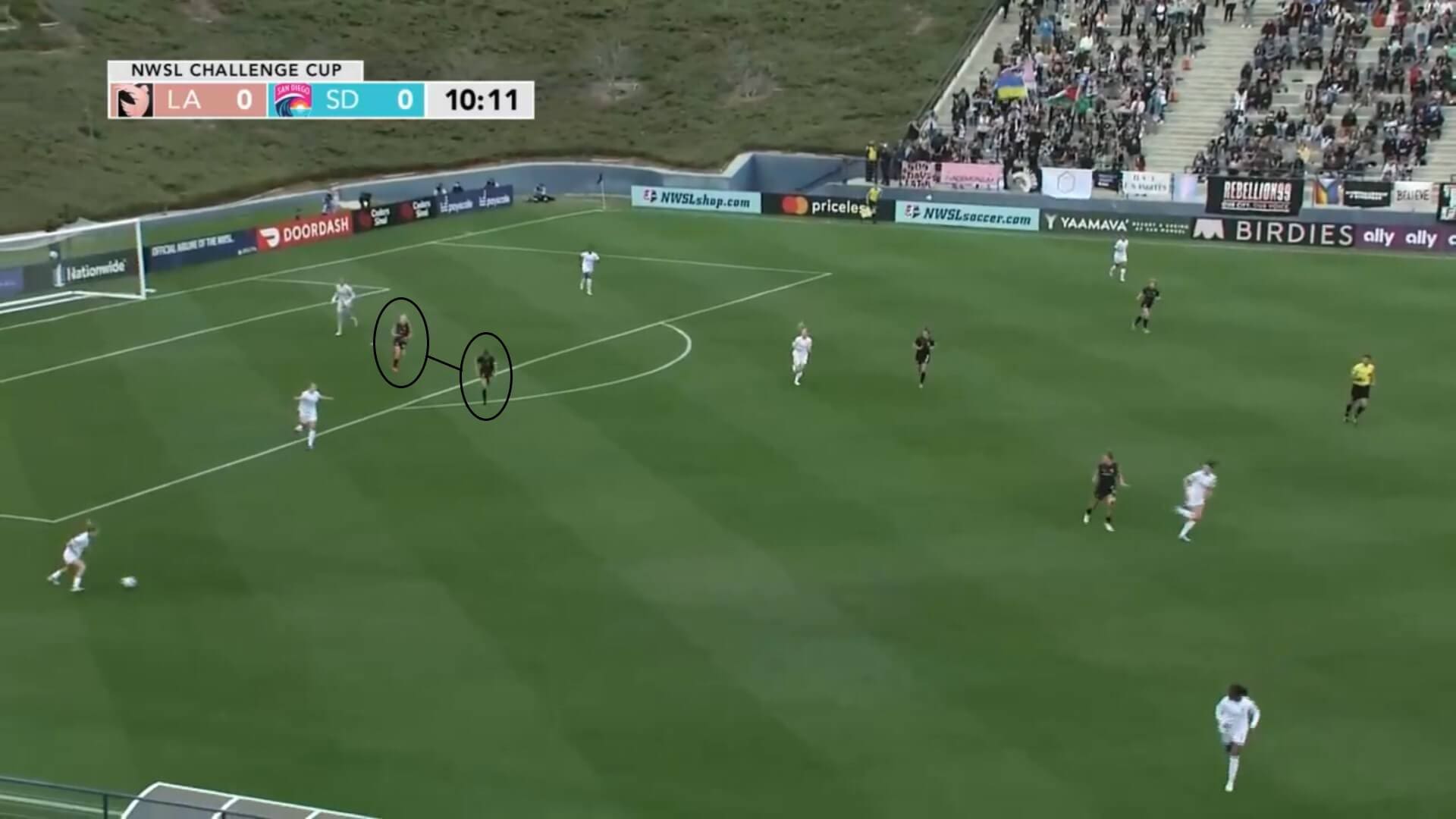
When attacking, it is clear that Freya Coombe wants her players to move around and link up with each other, and we constantly saw Christen Press cutting inside to work with Tyler Lussi in the central channel. Having this support benefitted Lussi, because she tends to play better when she has a strike partner, as was the case under Mark Parsons at Portland last season.
Press’s ability to come inside the field was vital to Angel City maintaining an attacking presence, because Lussi tended to drop back quite a lot and leave the box open, making it easier for San Diego to defend against them. As a result, when she did get the ball, it was usually a long way from goal, meaning that she ended up missing chances that, had she been in the box, she might have converted.
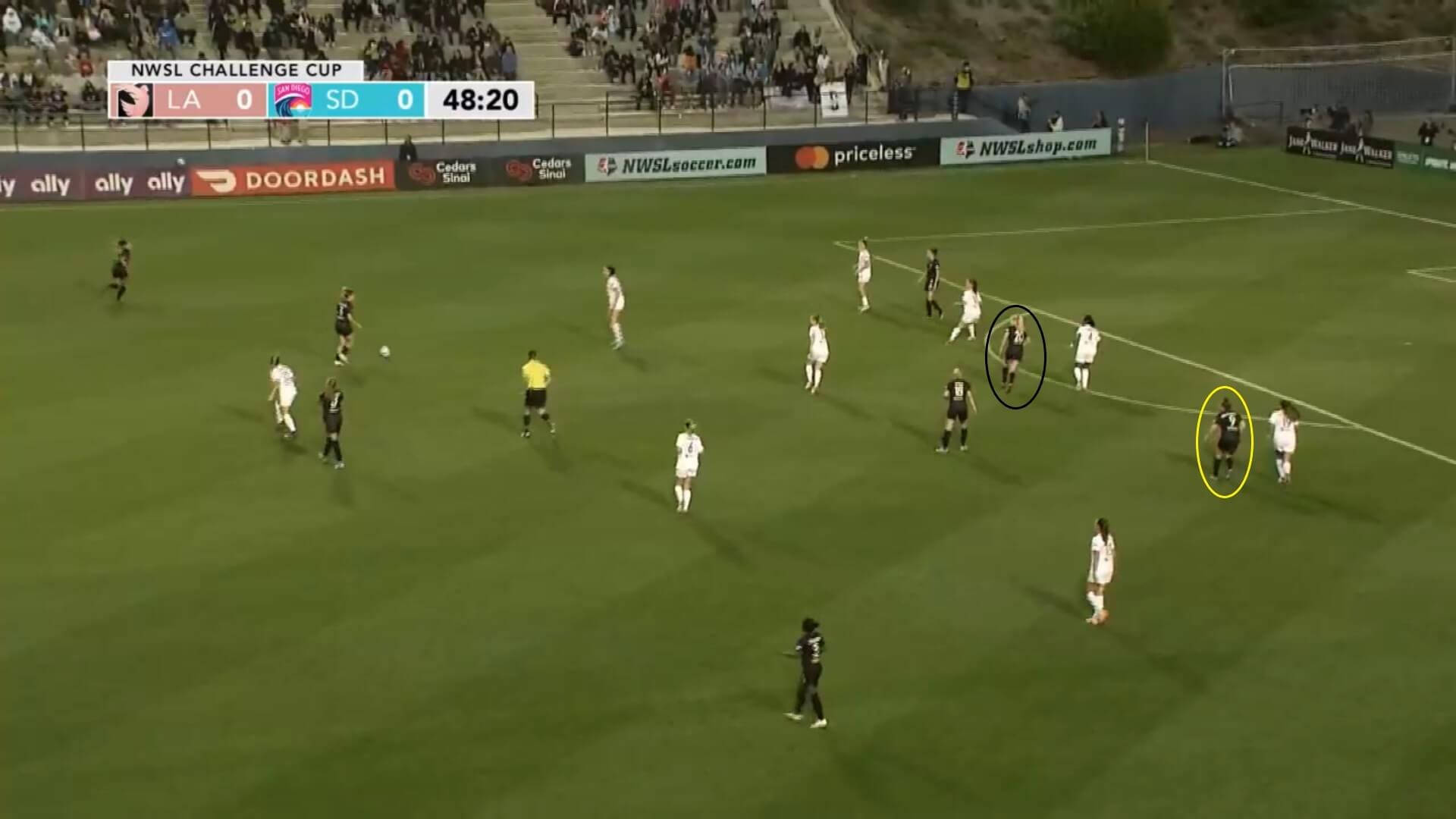
This was something that Coombe obviously noticed as well, because Lussi stayed further forward in the second half and gave the San Diego defenders more to think about, and this tactical alteration helped Angel City to take the lead. This image shows the build-up to their goal, with Ali Riley about to cross the ball in from the left wing, whilst Lussi is making a series of sharp movements that takes Naomi Girma’s focus away from the ball. As a result, when Riley does make her cross, there is space open in the middle for Savannah McCaskill, in the yellow circle, to head past Sheridan.
Getting Lussi further forward also benefitted the rest of the team, with both Jun Endo and McCaskill playing with an increased attacking freedom during the second half. As a result, Angel City created more chances and largely controlled proceedings after the break, and we can again see how their best moments came when they were on the front foot and moving the ball around at speed, taking us neatly back to the points made at the beginning of this section.
San Diego Wave’s attack
However, whilst Lussi’s positioning did contribute to Angel City’s first half struggles, San Diego Wave also need to take some credit for them, because their tidiness in possession made it hard for their opponents to have the ball and create opportunities.
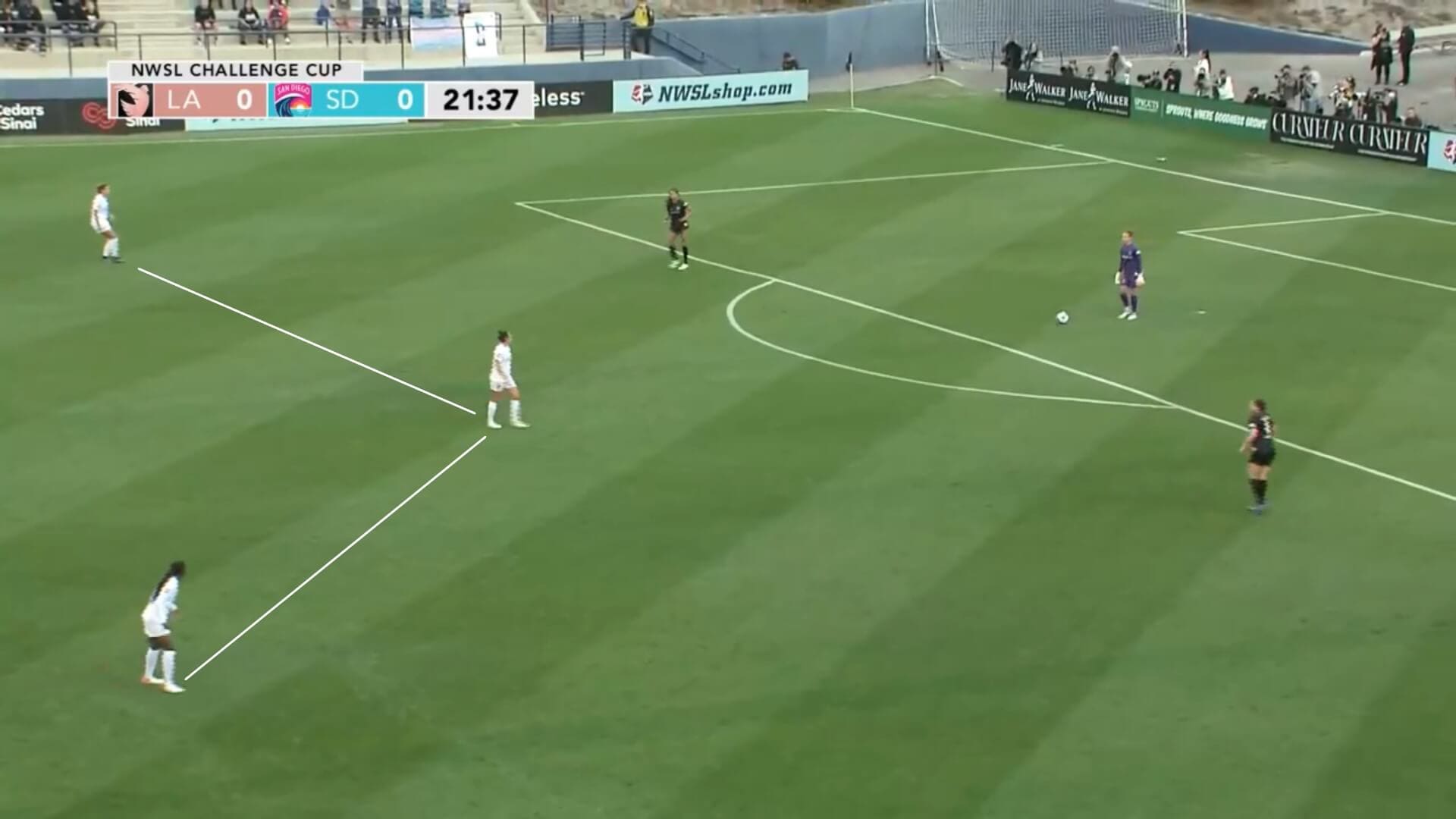
Whilst Angel City’s attack revolved around Press and Lussi working closely together, San Diego opted to push both of their wingers forward and form a front three, ensuring that Jodie Taylor never became isolated.
The advantage of this in-game shift from a 4-2-3-1 to a loose 4-3-3 is that the attacking midfielder, in this case Kelsey Turnbow, can drop back and become a playmaker between the midfield and attack. This is something that we know Casey Stoney likes to have, as England’s Ella Toone was given the same role for Manchester United Women last season, and it is likely that this is something she has introduced personally to San Diego’s tactics. Given the effectiveness with which she used it at Leigh Sports Village, we can expect her new team to set up with a midfield playmaker in the majority of their matches, and it did help them to control the first half of this game.
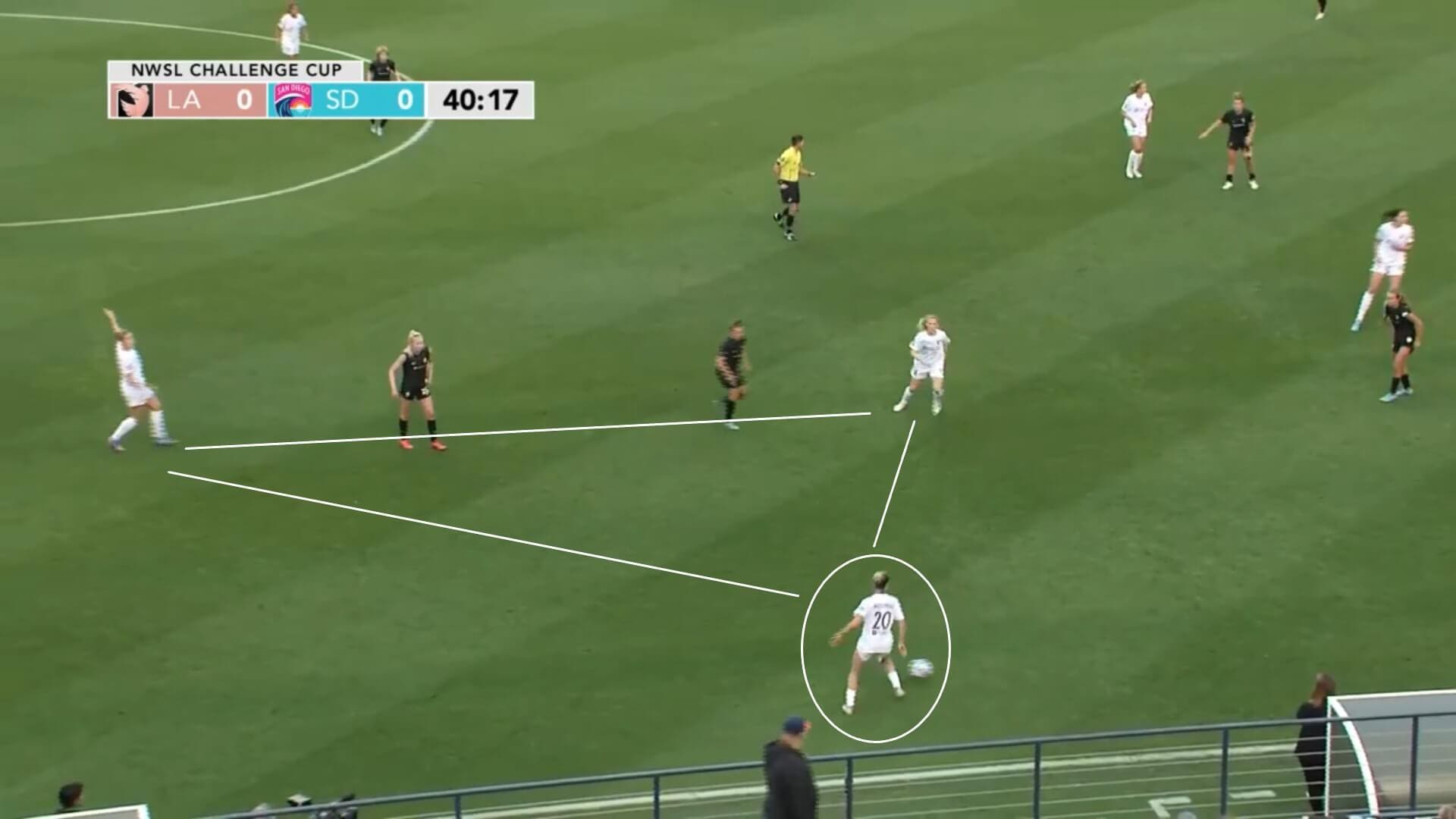
The confidence that San Diego had in possession was also demonstrated by their link-up play around the pitch. Christen Westphal in particular constantly got up the field and offered a passing option in the wide channel, whilst also allowing right winger Jun Endo to tuck inside the pitch and operate in the half-spaces, and their overall first half performance consisted of different shapes being created to help move the ball around their opponents with relative ease.
Angel City appeared unsure of whether to press and try to win the ball back or stay back and look to keep San Diego’s key players in front of them, and this indecision was another big reason that they struggled to establish themselves in the first half. However, as we said, San Diego deserve credit for the way that they moved the ball around and looked to win it back quickly whenever it was lost.
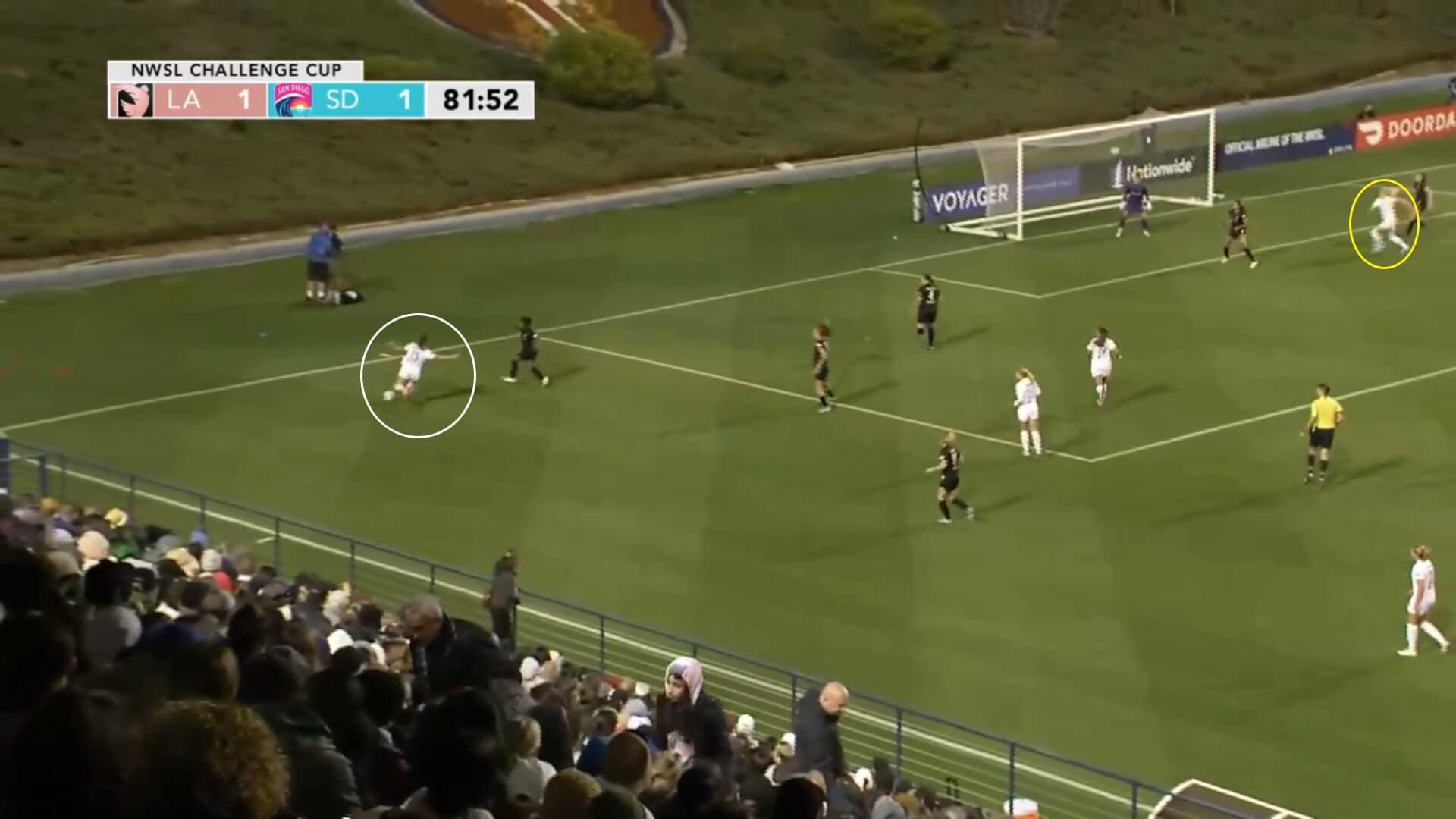
However, like their opponents, San Diego didn’t manage to score in the first half, despite going close on a number of occasions. The main reason for this was because Taylor didn’t have as much speed around the field as was at times required, and instead sat back when she perhaps needed to press forwards. Alex Morgan’s arrival at half-time may have been a pre-planned change, but it was one that was needed, because she made runs that hadn’t been made beforehand, penetrating the areas behind the Angel City defence and giving them more problems.
As well as this, they needed to address the lack of goal threat, and the introduction of former Real Madrid Femenino and Bayern Munich Frauen forward Sofia Jakobsson gave them a much quicker option inside the box. As this image shows, the combination of Morgan’s attacking runs and Jakobsson’s quick movement in the goal area helped San Diego to regain control of the game, and the corner that resulted in their late equaliser came from the duo’s teamwork. On the basis of this game, it looks as if San Diego’s hopes of scoring goals rest on how well the USA and Sweden internationals can link up with each other, and it will be interesting to see if this is what Casey Stoney looks to build their attack around in the future.
Where San Diego Wave can improve
However, as well as the positives in San Diego Wave’s performance, we also noticed a few areas where they need to keep improving, and addressing these smaller details will help them to be much harder to beat and more productive in the final third.
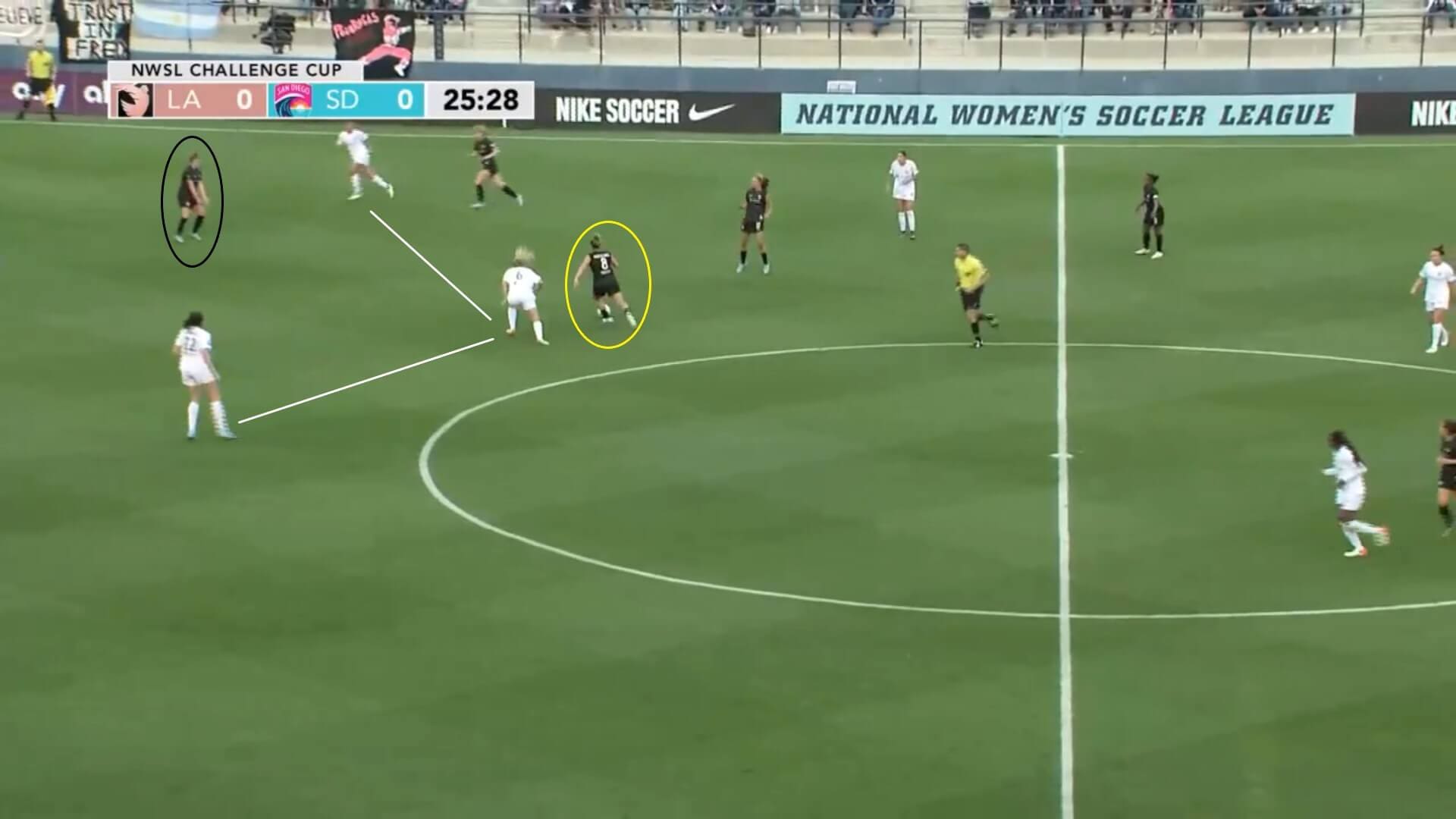
One thing to work on is their pressing when out of possession. Casey Stoney mentioned before the game that she was looking for her team to regain possession as quickly as possible once the ball had been lost, and there were clear examples of this throughout the game. However, they took a while to get used to it, with only one player pressing Cari Roccaro here, giving her time to play the ball forwards to McCaskill, who could then turn and pick out Press on the other side of the pitch.
We already know that Angel City like to play the ball through the thirds and at speed, and it seemed in situations like this that San Diego were allowing them to play that way. This was one reason for Angel City’s early control of the game.
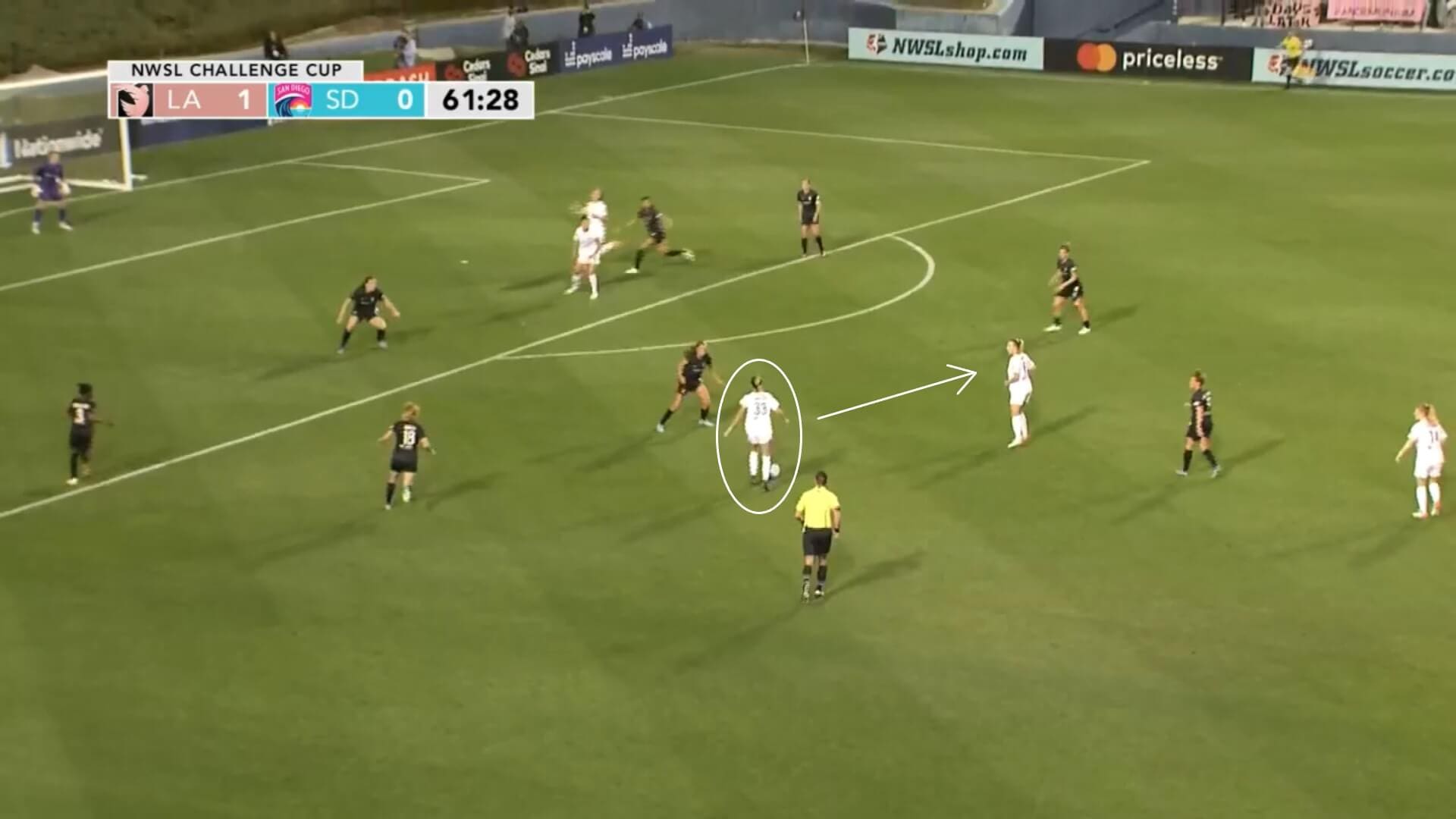
They also had a few issues with their confidence, as they didn’t have things all their own way in the second half, with Angel City getting back into the game and taking the lead, and this led to a lack of composure with the ball. In this case, Katie Johnson is looking to feed the ball inside and give her teammate the chance to run into the open space between the two defenders. However, she overhits her pass and it goes beyond her teammate, allowing Angel City to sweep up the ball and clear their lines. This is a small point to make, but it is only because they controlled the ball so well in the first half that it was so noticeable.
Whilst these are negative points to end on, what was evident throughout San Diego’s performance was that they have the basics nailed. Therefore, they can afford to focus on the finer areas of their play, because it is things like preventing a pass from being played and not giving the ball away cheaply that could make the difference between a draw and a win.
Conclusion
In conclusion, this tactical analysis has looked at why the opening game for Angel City and San Diego Wave ended as a 1-1 draw. Both controlled periods of play and moved the ball around well, but both also had moments when they lacked quality both in and out of possession. However, there is no doubt that Freya Coombe and Casey Stoney will both be pleased with a point, as it gives their teams something to build on ahead of the next round of matches. If we had to pick a team that would be happier with the result, it would perhaps be San Diego, with Stoney praising her side’s resilience and ability to fight their way back into the game, but there are positive signs that both can take, most notably that they are here to compete with the other teams in the league.
Angel City next host OL Reign, again at Titan Stadium, whilst San Diego are also at home to Portland, who visit the Torero Stadium on the back of their own 1-1 draw with OL. We will know a lot more about both Angel City and San Diego after those games, given that it will be the first time that they have faced established NWSL teams.





Comments